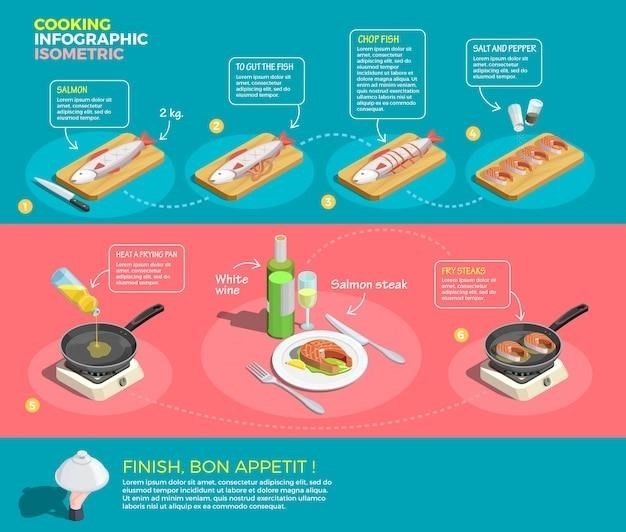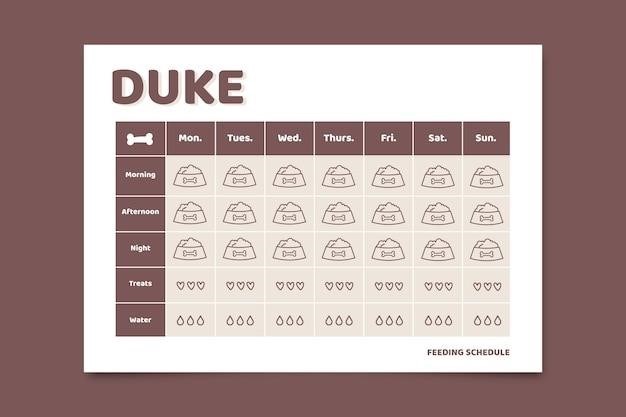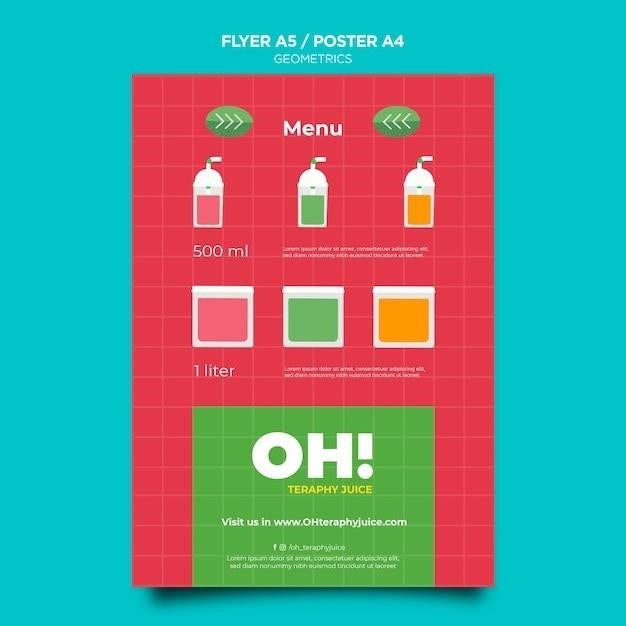Tableau Cuisson Sous Vide PDF⁚ A Comprehensive Guide

This comprehensive guide explores the world of sous vide cooking, providing essential information and practical tips to elevate your culinary skills․ Discover the benefits of sous vide, understand the process, explore essential equipment, and learn about temperature and time guidelines for various foods․
Introduction⁚ The Benefits of Sous Vide Cooking
Sous vide cooking, a French term meaning “under vacuum,” is a revolutionary culinary technique that has gained immense popularity in recent years․ This method involves immersing vacuum-sealed food in a precisely controlled water bath, ensuring even cooking and consistent results․ The benefits of sous vide cooking are numerous and make it an attractive option for both professional chefs and home cooks alike․
One of the most significant advantages of sous vide is its ability to produce perfectly cooked food every time․ By maintaining a constant temperature, the water bath eliminates the risk of overcooking or undercooking, resulting in consistent texture and optimal doneness․ This precision is particularly beneficial for delicate proteins like fish and poultry, ensuring that they are cooked to the desired level of tenderness and juiciness․
Another key advantage of sous vide is its ability to retain moisture and flavor․ The vacuum-sealed bags prevent the food from drying out, preserving its natural juices and enhancing its taste․ This is especially important for lean meats, which can easily become dry when cooked using traditional methods․ Sous vide cooking also allows for the infusion of flavors, as the food can be marinated or seasoned before being sealed in the bags․
Moreover, sous vide cooking offers greater flexibility and convenience․ Food can be cooked in advance and stored in the refrigerator, allowing for meal preparation ahead of time․ The technique also allows for precise temperature control, enabling the creation of dishes that would be difficult or impossible to achieve using conventional cooking methods․ From perfectly cooked steaks to tender roasts, sous vide opens up a world of culinary possibilities․
Understanding Sous Vide Cooking
Sous vide cooking is a precise and controlled method that involves immersing vacuum-sealed food in a water bath maintained at a specific temperature․ This process offers several advantages over traditional cooking methods, resulting in consistently cooked food with optimal texture and flavor․ To understand sous vide, it’s essential to grasp the key elements involved in this technique․
The first crucial element is vacuum sealing․ Food is carefully placed in a heat-resistant plastic bag, and the air is removed using a vacuum sealer․ This process creates an airtight environment, preventing the food from drying out and ensuring even cooking․ Vacuum sealing also allows for the infusion of flavors, as the food can be marinated or seasoned before being sealed․
The second essential element is the water bath․ A sous vide cooker, often referred to as an immersion circulator, is used to maintain the water bath at a precise temperature․ The circulator continuously circulates the water, ensuring uniform heat distribution throughout the bath․ This precise temperature control is crucial for achieving consistent cooking results․
The final element is the cooking time․ The duration of the sous vide cooking process varies depending on the type of food and the desired level of doneness․ However, the general principle is that food is cooked at a lower temperature for a longer period than traditional methods․ This allows the proteins to break down and become more tender, resulting in a more flavorful and succulent dish․
Essential Equipment for Sous Vide Cooking
Embarking on the sous vide journey requires a few essential pieces of equipment to ensure a successful culinary experience․ While the core components are readily available, understanding their roles and choosing the right ones for your needs is crucial․
The first and foremost piece of equipment is the sous vide cooker, also known as an immersion circulator․ This device is responsible for maintaining the precise temperature of the water bath․ It typically consists of a heating element, a temperature sensor, and a pump that circulates the water․ Sous vide cookers come in various sizes and power levels, catering to different needs and cooking volumes․
Next, a vacuum sealer is indispensable for the sous vide process․ It removes air from the plastic bag, creating an airtight seal that prevents food from drying out and ensures even cooking․ Vacuum sealers are available in various models, from basic hand-operated versions to more advanced automatic options․
A reliable thermometer is crucial for monitoring the internal temperature of the food during the sous vide process․ While the sous vide cooker maintains the water bath temperature, a thermometer allows you to check the food’s core temperature for optimal doneness․ A meat thermometer with a probe is recommended for accurate readings․

Finally, heat-resistant plastic bags are essential for vacuum sealing the food․ These bags are designed to withstand high temperatures and are available in various sizes․ Choose bags specifically designed for sous vide cooking, as they are typically thicker and more durable․
Sous Vide Temperature Chart for Various Foods
A sous vide temperature chart is an invaluable tool for achieving consistent and perfectly cooked results․ It provides a comprehensive guide to the optimal temperatures for various foods, ensuring that you achieve your desired level of doneness․ While the chart serves as a starting point, remember that personal preferences and individual food characteristics may necessitate adjustments․
For meats, the chart outlines temperatures for different levels of doneness, from rare to well-done; For beef, temperatures typically range from 129°F (54°C) for rare to 140°F (60°C) for medium-well․ Poultry, such as chicken and turkey, requires higher temperatures, with 165°F (74°C) being the recommended minimum for safe consumption․
Fish and seafood benefit from sous vide cooking, as it allows for delicate and flavorful results․ The chart suggests temperatures ranging from 125°F (52°C) for delicate fish like cod to 135°F (57°C) for firmer fish like tuna․ Shellfish, such as shrimp and scallops, can be cooked at temperatures around 140°F (60°C)․
Beyond meats and seafood, the temperature chart also includes guidance for vegetables․ Vegetables benefit from sous vide cooking, as it helps to retain their vibrant colors and flavors․ The chart suggests temperatures ranging from 185°F (85°C) for root vegetables like carrots and potatoes to 195°F (91°C) for leafy greens like spinach and kale․
Sous Vide Cooking Times for Different Cuts of Meat
Sous vide cooking times for different cuts of meat are influenced by several factors, including the thickness of the cut, the desired level of doneness, and the specific type of meat․ A comprehensive sous vide cooking time chart provides a general guide, but adjustments may be necessary based on individual preferences and specific circumstances․
For steaks, thinner cuts like filet mignon typically require shorter cooking times than thicker cuts like ribeye or New York strip․ A 1-inch thick steak may cook for 1․5 to 2 hours, while a 2-inch thick steak may require 2․5 to 3 hours․ For roasts, cooking times are significantly longer, with a 3-4 pound roast potentially requiring 4-6 hours․
The desired level of doneness also plays a crucial role in determining cooking times․ Rare steaks typically cook for shorter periods than medium-rare or well-done steaks․ For example, a rare steak may be cooked for 1․5 hours, while a well-done steak may require 2․5 hours․
The type of meat also impacts cooking times․ Chicken breasts generally require shorter cooking times than chicken thighs, while pork tenderloin cooks faster than pork shoulder․ The chart provides a general guideline for different cuts of meat, but it’s always advisable to check the internal temperature using a meat thermometer to ensure proper doneness․
Sous Vide Cooking Techniques⁚ A Step-by-Step Guide
Sous vide cooking techniques are straightforward and relatively simple to master․ The process involves precise temperature control, which ensures consistent results and eliminates the risk of overcooking or undercooking․ Here’s a step-by-step guide to help you achieve perfect sous vide results⁚
Prepare the Food⁚ Season the food generously with salt, pepper, and any desired herbs or spices․ For thicker cuts of meat, consider making small incisions to allow the seasoning to penetrate more effectively․
Vacuum Seal⁚ Place the prepared food in a vacuum-seal bag, ensuring that all air is removed․ If you don’t have a vacuum sealer, you can use a zip-top bag, removing as much air as possible before sealing․
Set the Water Bath⁚ Fill a large pot or container with water and set it to the desired temperature using a sous vide circulator․ The circulator will maintain a precise temperature throughout the cooking process․
Immerse the Bag⁚ Gently place the vacuum-sealed bag of food into the water bath, ensuring it’s fully submerged․ Allow the food to cook for the recommended time, as specified in the sous vide chart․
Finalizing the Dish⁚ After cooking, remove the bag from the water bath and pat the food dry․ For a crispy sear, pan-fry or grill the food briefly to achieve a delicious crust․ You can also finish the dish by adding a sauce or glaze to enhance the flavors․
Tips and Tricks for Perfect Sous Vide Results
While sous vide cooking is known for its simplicity and consistency, a few tips and tricks can help you elevate your results and ensure perfect outcomes․ Here’s a collection of valuable insights to enhance your sous vide journey⁚
Accurate Temperature Control⁚ The key to sous vide cooking lies in maintaining precise temperature throughout the cooking process․ Invest in a high-quality sous vide circulator that offers accurate temperature control and stability․
Properly Seal the Bag⁚ Ensure a tight seal on your vacuum-seal bag to prevent water from entering during cooking․ If using a zip-top bag, remove as much air as possible, leaving minimal room for air pockets․
Don’t Overcrowd the Bath⁚ Avoid overcrowding the water bath to ensure even heat distribution and prevent temperature fluctuations․ Allow enough space between the bags for proper water circulation․
Consider the Doneness⁚ Remember that sous vide cooking cooks the food to a specific temperature․ If you prefer a different level of doneness, adjust the cooking time accordingly or sear the food after cooking to achieve the desired level of browning․
Embrace Experimentation⁚ Sous vide cooking opens up a world of culinary possibilities․ Don’t be afraid to experiment with different ingredients, seasonings, and cooking times to discover your own favorite combinations․
Sous Vide Recipes⁚ A Taste of Possibilities
Sous vide cooking unlocks a world of culinary possibilities, allowing you to create dishes that are both flavorful and perfectly cooked․ From succulent meats to tender vegetables, the possibilities are endless․ Here are some recipe ideas to inspire your culinary adventures⁚
Sous Vide Steak⁚ This classic sous vide recipe delivers perfectly cooked steak with a juicy interior and a flavorful crust․ Season your steak generously with salt and pepper, then vacuum seal and cook at 130°F (54°C) for 1․5-2 hours for medium-rare․ After cooking, sear the steak in a hot pan for a crispy crust․
Sous Vide Salmon⁚ Sous vide salmon yields a delicate and flaky texture, ensuring that the fish is cooked evenly without drying out․ Season the salmon with your favorite herbs and spices, then vacuum seal and cook at 125°F (52°C) for 15-20 minutes․ Serve with a squeeze of lemon and your favorite side dishes․
Sous Vide Chicken Breast⁚ Sous vide chicken breast is a foolproof way to create moist and flavorful chicken․ Season the breasts with your favorite marinade or rub, then vacuum seal and cook at 145°F (63°C) for 1-1․5 hours․ After cooking, you can pan-sear or roast the chicken to achieve a crispy skin․
Sous Vide Eggs⁚ Sous vide eggs are a delightful way to achieve perfectly cooked eggs with a creamy yolk and a tender white․ Crack the eggs into a vacuum-seal bag and cook at 145°F (63°C) for 45 minutes to 1 hour․ Serve with toast, avocado, or your favorite breakfast accompaniments․
Sous Vide Vegetables⁚ Sous vide cooking is a fantastic way to cook vegetables without overcooking them; Tenderize your favorite vegetables like asparagus, broccoli, and carrots by vacuum sealing them with a little olive oil, salt, and pepper, then cooking at 185°F (85°C) for 15-20 minutes․ You can also use this method to create flavorful vegetable purees or sauces․
